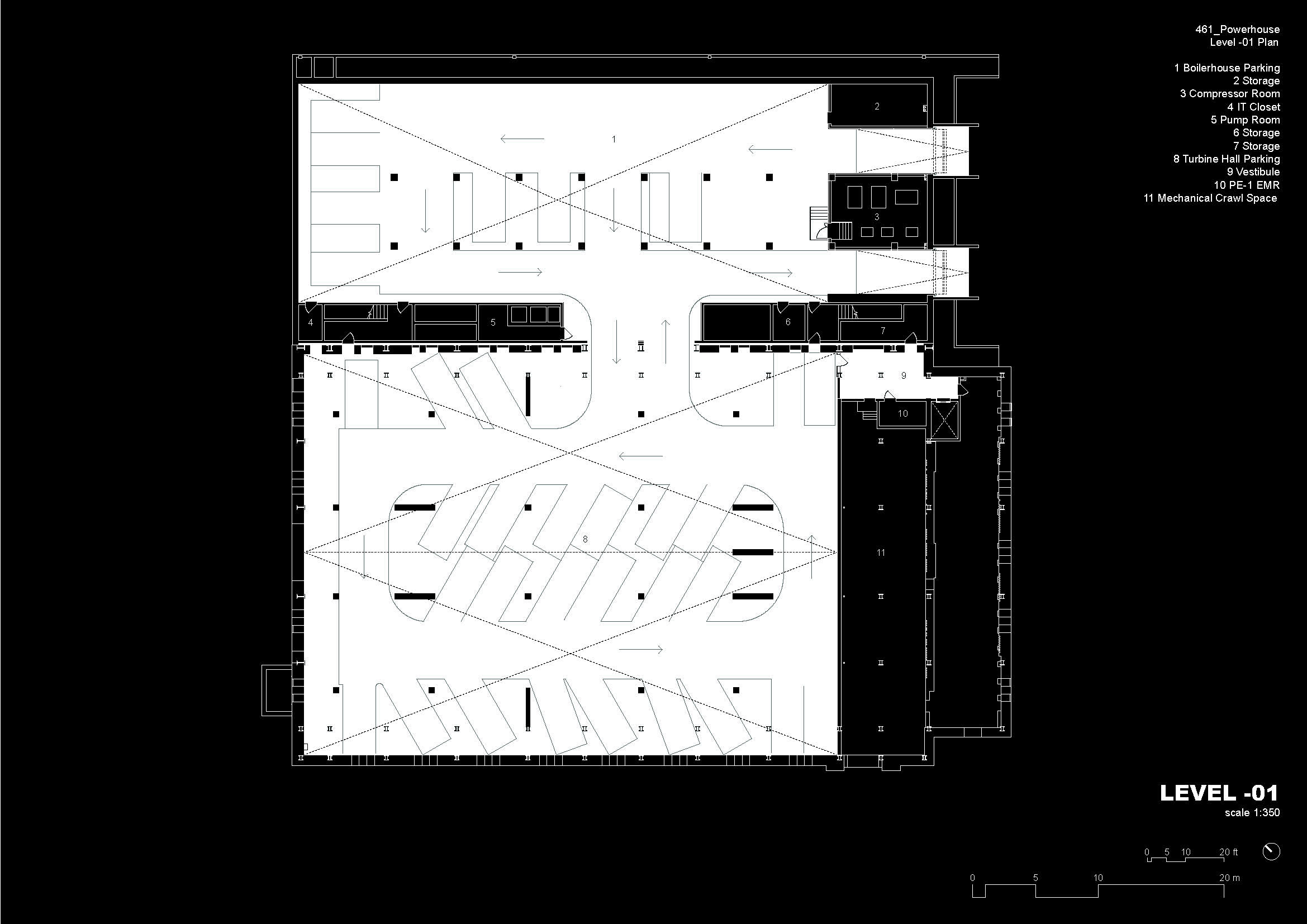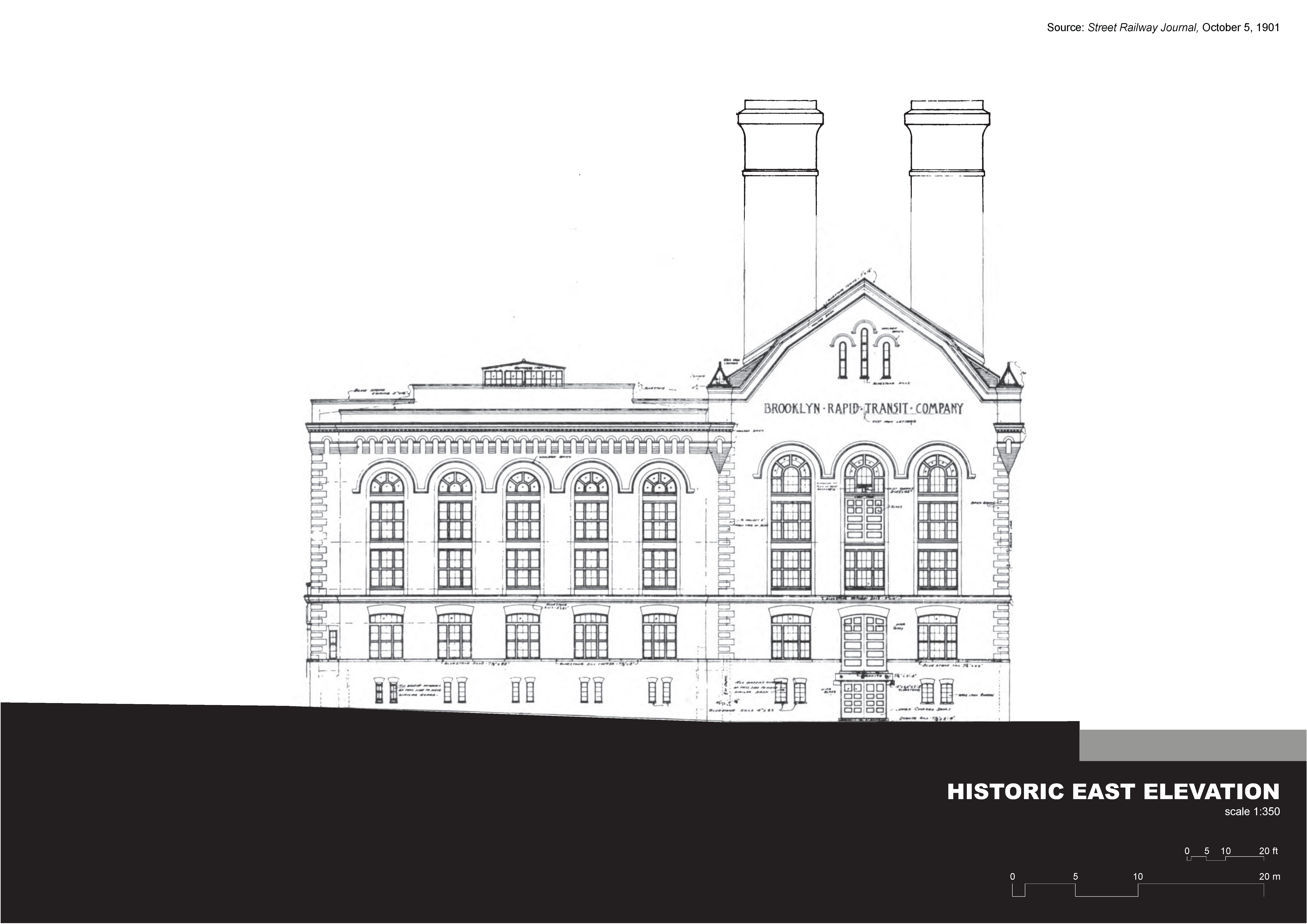

设计单位 赫尔佐格与德梅隆
项目地点 美国纽约
建成时间 2022年
建筑面积 16270平方米
本文英文原文由设计单位提供。
电厂艺术中心(Powerhouse Arts)是一个非营利性的艺术生产空间,位于纽约布鲁克林区的戈瓦纳斯(Gowanus)和红钩(Red Hook)社区,其建立为艺术生产和艺术就业提供了更大的机会。该重建项目包含17万平方英尺(约15794平方米)的工作坊车间,可用于木材、金属、陶瓷、纺织品和印刷品的制造;它将一个受污染的废弃建筑改造成了艺术家、制造者和其他工人的共享艺术中心,并使得该地的工业遗产得以延续。项目将一个有115年历史的发电厂重新设计成一个现代化的艺术生产空间,并保留了布鲁克林历史工业区的制造业传统;通过保护、恢复和重建原有发电站的基本设施,体现并加强了建筑的工业特征及其与周边城市环境的关系。
Powerhouse Arts is a not-for-profit manufacturing facility based in Gowanus and Red Hook, Brooklyn, New York, established to create a robust platform for art production and employment in the arts. Consisting of 170,000 square feet of workshop space for fabrication in wood, metal, ceramics, textile and print, the redevelopment project transforms an existing, derelict structure on a contaminated site into a hub for artists, fabricators and other workers and ensures that the industrial legacy of the site will extend into the next century. Reimagining a 115-year-old power plant as a modern production facility, the project aims to maintain a manufacturing presence in a historically industrial part of Brooklyn. By preserving, restoring, and reconstructing essential elements of the original power station, the project strengthens the building’s industrial character and its relationship to the immediate urban context.


该项目位于戈瓦纳斯运河沿岸,是西边的红钩和卡罗尔花园(Carroll Gardens)社区与东边的公园坡(Park Slope)社区之间的一个自然低点。1904年,由托马斯·爱德华·默里(Thomas Edward Murray)设计的布鲁克林捷运发电站(Brooklyn Rapid Transit Power Station)在该地建成,服务于布鲁克林不断扩大的交通系统。
The project is situated along the Gowanus Canal, a natural low point between the neighborhoods of Red Hook and Carroll Gardens to the west and Park Slope to the east. In 1904, the Brooklyn Rapid Transit Power Station, designed by Thomas Edward Murray, was completed on the site to serve the expanding transit system of Brooklyn.


20世纪50年代发电站不再使用后,原结构的一半——锅炉房被拆除,只留下涡轮大厅。在20世纪末,余下的结构成为当地涂鸦艺术家的热门去处,并获得了“蝙蝠洞”(The Batcave)的绰号。随后,戈瓦纳斯运河在2010年被美国环境保护局(EPA)认定为“超级基金”(Superfund)场地,被确定为需要修复的地区。在施工开始之前,该场地的污染已经通过纽约州棕地清理计划(Brownfield Cleanup Program)得到了解决。2016年4月,经过场地概念设计的初步筛选,赫尔佐格与德梅隆被任命为项目的设计顾问。
Decommissioned in the 1950s, half of the original structure – the Boiler House – was demolished, leaving the Turbine Hall to stand by itself. In the late twentieth century, the remaining structure became a destination for local graffiti artists, and it earned the nickname of “The Batcave.” Subsequently, the Gowanus Canal was designated a Superfund site in 2010 by the United States Environmental Protection Agency, identifying it as a candidate for remediation. Prior to the start of construction, the site contamination was resolved through completion of the New York State Brownfield Cleanup Program. In April 2016 – after an initial selection process that included a concept design for the site – Herzog & de Meuron was appointed as design consultant for the project.


该地区汇集了库房、仓库和多功能商业建筑,并且正在迅速地向着高档化的方向发展。现有建筑的西面是戈瓦纳斯运河的边缘,北面是第一街,南面是第二街,东面是第三大道上的一个大型仓储建筑。由于涡轮大厅的规模较大,并处于相对较高的地面上,因而它在周边环境中显得十分突出。
A mix of storage sheds, warehouses, and mixed-use, commercial buildings, the neighborhood is rapidly gentrifying. The existing building is set back from the edge of the Gowanus Canal to the west and bound at the north by First Street, at the south by Second Street, and at the east by a large storage building along Third Avenue. The scale of the Turbine Hall and its location atop relatively high ground give it a visual prominence in the neighborhood.
该地的工业景观和历史在设计方案中发挥了关键作用。设计通过恢复锅炉房的体量,并重建其与现有涡轮大厅的关系,为历史上旧有的锅炉房加入了新的诠释。涡轮大厅被保留下来,通过妥善和战略性的修复,其历史属性也被整合到新的建筑空间中。
The industrial landscape and history of the site play a pivotal role in the design proposal. It reinterprets the historic Boiler House by reinstating its mass and re-establishing its relationship with the existing Turbine Hall. The Turbine Hall is preserved – stabilized and strategically repaired – and its historical layers are integrated into the new manufacturing facility.

复原后的锅炉房位于现有的历史地基上,这样的做法最大限度地减少了对场地的挖掘。它的混凝土外墙与现有涡轮大厅的砖石外壳相呼应,简单而耐用。其内部的混凝土柱和板等裸露结构,为工作坊车间提供了灵活的空间。涡轮大厅的原有穿孔开口也被纳入到锅炉房的围护结构中,两座建筑都装满了新的窗户。
The reinstated Boiler House bears on the existing, historic foundations, minimizing further site excavations. Its concrete façade responds to the existing masonry shell of the Turbine Hall and provides a durable and straightforward envelope for the addition. The exposed structure at the interior, comprising concrete columns and slabs, provides flexible spaces for workshop use. The historic, punched openings of the Turbine Hall are incorporated into the Boiler House envelope, and the openings of both buildings are filled with new windows.

作为一个工业项目,该艺术中心与其他建筑不同的点在于,它各个工作坊车间是垂直堆叠的,因而需要确立清晰的高度,并合理规划装载区域。例如金属和木材车间位于底层,而对排气要求最严格的车间,如印刷、纺织和陶瓷则位于锅炉房的顶层。项目遵循工业卫生的做法要求,并咨询了多位专家得以完善方案;建筑通过设计将大量的空气排出,以确保制造过程中的污染物不会对内部工作环境产生不利影响。
Atypically for an industrial project, the respective fabrication shops are stacked vertically with the disciplines requiring the most clear height and best access to the loading areas – that is, the metal and wood workshops – located on the ground floor, while the disciplines with the most stringent exhaust requirements – print, textile and ceramics – are located at the top floors of the Boiler House. Adhering to the best practices of industrial hygiene (refined through consultation with several specialists), a large amount of air is exhausted from the building to ensure contaminates from the manufacturing processes do not adversely affect the interior work environment.




为了达到上述的目的,设计团队设置了一个共享的大型垂直服务空间来辅助,其中还包含有楼梯、电梯,以及洗手间的管道等设施。现有建筑和新建筑之间这些垂直功能的合并,在结构上增加了两座建筑的横向稳定性;并在锅炉房已有的框架下,使得工作坊车间可以更灵活。另外,屋顶的两个大型隔墙体现了机械、电气、管道和消防系统在该项目中的重要性,它的体量也让人想起历史上原锅炉房的烟囱;同时它们也说明了建筑具备的弹性——考虑到未来可能发生洪水和海平面上升的情况,这些设备被安装在屋顶而不是底部。
To that end, the workshops share a common, large vertical service wall that also contains the vertical circulation elements, stairs and elevators, as well as the restroom plumbing stack. The consolidation of these vertical elements between the existing and the new building provides additional lateral, structural stability for both buildings and creates the flexibility required for workshop programming within the remainder of the Boiler House floor slab. Two large bulkhead volumes at the roof express the primacy of the mechanical, electrical, plumbing, and fire protection systems in the project and recall the historic smokestacks of the original Boiler House building. They also illustrate the resiliency of the facility, as no equipment has been installed at the base of the building given the potential for flooding and sea level rise in the future.

在项目的西侧,沿着戈瓦纳斯运河有一个前院,可作为灵活的户外工作场地和存储空间,同时可用于材料运送的装载。在项目的东侧靠近公共交通的地方,有建筑的主入口,即涡轮大厅砖石立面上的一个新开口。进入建筑后,游客可以看到历史细节的并置,混凝土拱顶、砖槽和釉面瓷砖、残留的涂鸦和新的建筑元素交相呼应。建筑内有非常显著的特征:巨大的混凝土剪力墙在入口大厅之外形成垂直空间,金属楼梯将人们的注意力引向大厅。涡轮大厅的整个上部,都保留了原始空间的构成,将顶部翻新的钢桁架暴露出来;大厅为展览和活动提供了一个多功能的空间。相邻的锅炉房里,一个双层通高的体量作为公共区域和工作坊车间的交汇点,为展览、活动、舞台和集会提供额外的空间。
To the west of the project along the Gowanus Canal, a forecourt provides flexible outdoor work and storage space as well as loading for material deliveries. To the east of the project, closer to the approach to the site from public transit, a new opening into the masonry envelope of the Turbine Hall serves as the primary public entrance. Upon entering the building, the visitor is confronted with the juxtaposition of historic details – concrete vaults, brick chases, and glazed tilework – residual graffiti and the new architectural elements. A large, concrete shear wall forms a vertical space beyond the entrance lobby and a metal stair draws attention upward to the grand hall, the main public feature within the building. The entire upper level of the Turbine Hall building preserves the original spatial composition of the historic structure, exposing the refurbished, steel trusses overhead, and providing a multifunctional space for exhibitions and events. An adjacent, double-height volume in the Boiler House serves as the intersection of the public and workshop functions in the building, providing additional room for exhibitions, events, staging, and assembly.


设计图纸 ▽



















完整项目信息
PROJECT KEY DATA
Project Number: 461
Project Official Name: Powerhouse Arts
Location: 322 Third Avenue Brooklyn, New York, USA
Project Phases:
Concept Study: Jan 2016 - Nov 2016
Schematic Design: Nov 2016 - Jun 2017
Design Development: Jun 2017 - Feb 2018
Construction Documents: Mar 2018 - Dec 2018
Construction Administration: Jan 2019 - Mar 2022
Milestones:
Construction Start: 27 Dec 2018
Topping Out: 21 Apr 2020
Permit:
Foundation & Partial Alt 1 Permit: 09 Jan 2019
Client: Powerhouse Arts, Brooklyn, New York, USA
Client Representative: Colliers International, New York, New York, USA
PROJECT TEAM
Herzog & de Meuron Project Team:
Partners: Jacques Herzog, Pierre de Meuron, Ascan Mergenthaler (Partner in Charge)
Project Team: Philip Schmerbeck (Associate, Project Director), Jack Brough (Project Manager, SD - CA), Raha Talebi (Project Manager, Competition - Pre-SD)
Farhad Ahmad, Bruno de Almeida Martins, Iwona Boguslawska, Christopher Cornecelli, Lasse Deichmann, Muriz Djurdjevic, Nazli Ergani, Florian Frank, Fabiola Guzman-Rivera, Josh Helin, Magnus Overby, Pedro Peña Jurado, Martin Jonathan Raub, Rebecca Roberts, Emma Thomas, Pimchanok Wangveeramit, Samuels Zeif
PLANNING
Design Consultant: Herzog & de Meuron Basel Ltd, Basel, Switzerland
Executive Architect: Platt Byard Dovell White Architects, New York, New York, USA
Structural Engineering: Robert Silman Associates Structural Engineers, New York, New York, USA
MEP Engineering: Buro Happold Engineering, New York, New York, USA
Cost Consulting: Stuart-Lynn Company, New York, New York, USA
Landscape Architect (Waterfront): Ken Smith Workshop, New York, New York, USA
Construction Management: Urban Atelier Group, New York, New York, USA
SPECIALIST / CONSULTING
Concrete Consulting: Reg Hough Associates, Freehold, New Jersey, USA
Facade Consulting: Eckersley O'Callaghan, New York, New York, USA
Lighting Consulting: Tillotson Design Associates, New York, New York, USA
Traffic Consulting: Philip Habib and Associates, New York, New York, USA
Civil Engineering: Philip Habib and Associates, New York, New York, USA
Geotechnic Consulting: Langan Engineering and Environmental Services, New York, New York, USA
Environmental Engineering: Roux Associates, Islandia, New York, USA
Fire Protection Consulting: Cosentini Associates, New York, New York, USA
Vertical Circulation Consulting: Van Deusen and Associates, New York, New York, USA
Building Code Consulting: Metropolis Group, New York, New York, USA
Industrial Hygiene: Arts, Crafts and Theater Safety, Inc., New York, New York, USA
Other: Gordon Air Quality Consultants, Billerica, Massachusetts, USA
Masonry Restoration (planning): ICR-ICC, New York, New York, USA
Masonry Restoration (implementation): Eugene Architecture, New York, New York, USA
Acoustic Consulting: Longman Lindsey, New York, New York, USA
IT Consulting: Shen Milsom & Wilke, New York, New York, USA
Surveyor: Building Survey Corporation, Carle Place, New York, USA
Surveyor: Perfect Point Land Surveying, Brooklyn, New York, USA
Theatre Consulting: Charcoalblue, New York, New York, USA
CONTRACTORS
Concrete Works: Structure Tech NY, New York, New York, USA
Steel Construction: Maspeth Welding, Maspeth, New York, USA
Facade Restoration: New Roc Contracting, Fort Lee, New York, USA
Aluminum Windows: STNY Curtainwalls, New York, New York, USA
Excavation & Environmental Remediation: Darcon Construction, Elmont, New York, USA
Heating, Ventilation, Air Conditioning: Eastern Air Inc., Brownstown, Pennsylvania, USA
Plumbing Works: Donato Plumbing, Inc, Brooklyn, New York, USA
Electrical Installations: Centrifugal Electric, LLC, New York, New York, USA
Lighting Fixtures: Chelsea Lighting, New York, New York, USA
Lighting Fixtures: Litelab, Buffalo, New York, USA
Masonry: Bunlin LLC, Sunnyside, New York, USA
Architectural Millwork: PGS Millwork, Inc., Hudson, New York, USA
Floor Finishes: Grayfox Flooring, New York, New York, USA
Prefabricated Metal Construction: Workspace 11, Brooklyn, New York, USA
Prefabricated Metal Construction: CMG, New York, New York, USA
Exterior Metalworks: PG New York, Yonkers, New York, USA
Interior Metalworks: Tetra, Staten Island, New York, USA
Metal Doors: Long Island Fireproof Door, Flushing, New York, USA
BUILDING DATA
Site Area: 108'725 sqft / 10'100 m²
Gross floor area (GFA): 175'130 sqft / 16'270 m²
GFA above ground: 146'695 sqft / 13'628 m²
GFA below ground: 28'435 sqft / 2'641 m²
Outside Facilities: 74'375 sqft / 6'909 m²
Number of levels: 6
Footprint: 34'350 sqft / 3'191 m²
Length: 188 ft / 57 m
Width: 180 ft / 54 m
Height: 128 ft / 39 m
Gross volume (GV): 3'248'550 cbft / 91'988 m3
Facade surface: 78'530 sqft / 7'295 m²
DETAILED DATA
Building Components:
Existing Building - Turbine Hall
New Building - Boiler House
Gate House (3rd Avenue)
Forecourt (Canal)
Building Footprint (GFA):
20,300 sqft / 1,886 m² (Turbine Hall)
11,750 sqft / 1,092 m² (Boiler House)
300 sqft / 28 m² (Gate House)
32,075 sqft / 2,980 m² (Below Grade Parking)
Use / Function
Metal Workshop: Located in Turbine Hall - Level 01
Wood Workshop: Located in Boiler House - Level 01
Print Workshop: Located in Boiler House - Level 04, 05
Textile Workshop: Located in Boilerhouse - Level 05
Ceramics Workshop: Located in Boilerhouse - Level 06
Grand Hall - Assembly & Staging: Located in Turbine Hall - Level 03
Small Hall & Classrooms: Located in Turbine Hall - Level 02
Small Metals: Located in Boiler House - Level 02
Entrance Lobby & Cafe: Located in Turbine Hall - Level 01
Administrative Offices: Located in Turbine Hall - Level 02
Event Hall: Located in Boiler House - Level 03
Fit Out / Furniture
Custom Lighting Fixtures (Lobby, Grand Hall): Litelab Lighting Solutions (Rick Spaulding), Buffalo, New York, USA
Old-Growth Reclaimed Heartpine Furniture & Millwork (Lobby): PGS Millwork (Gary Lecce), Hudson, New York, USA
Old-Growth Reclaimed Heartpine Flooring (Lobby): Hudson Flooring, Pine Plains, New York, USA
Custom Metal & Glass Partitions & Doors: Workspace 11 (Norman Mooney), Brooklyn, New York, USA
Material / Manufacturers
Custom 'Powerhouse Red' Concrete Tint: E & A Supply Corporation, Nesconset, New York, USA
Custom Unitized Windows: Stahlbau Pichler, Italy, Bolzano
版权声明:本文由Herzog & de Meuron授权发布。欢迎转发,禁止以有方编辑版本转载。
投稿邮箱:media@archiposition.com
上一篇:玛雅文明的“星团”:墨西哥卡奈瑞吉度假酒店 / Edmonds International
下一篇:无界生长:浙江大学衢州“两院” / 法国AS建筑工作室